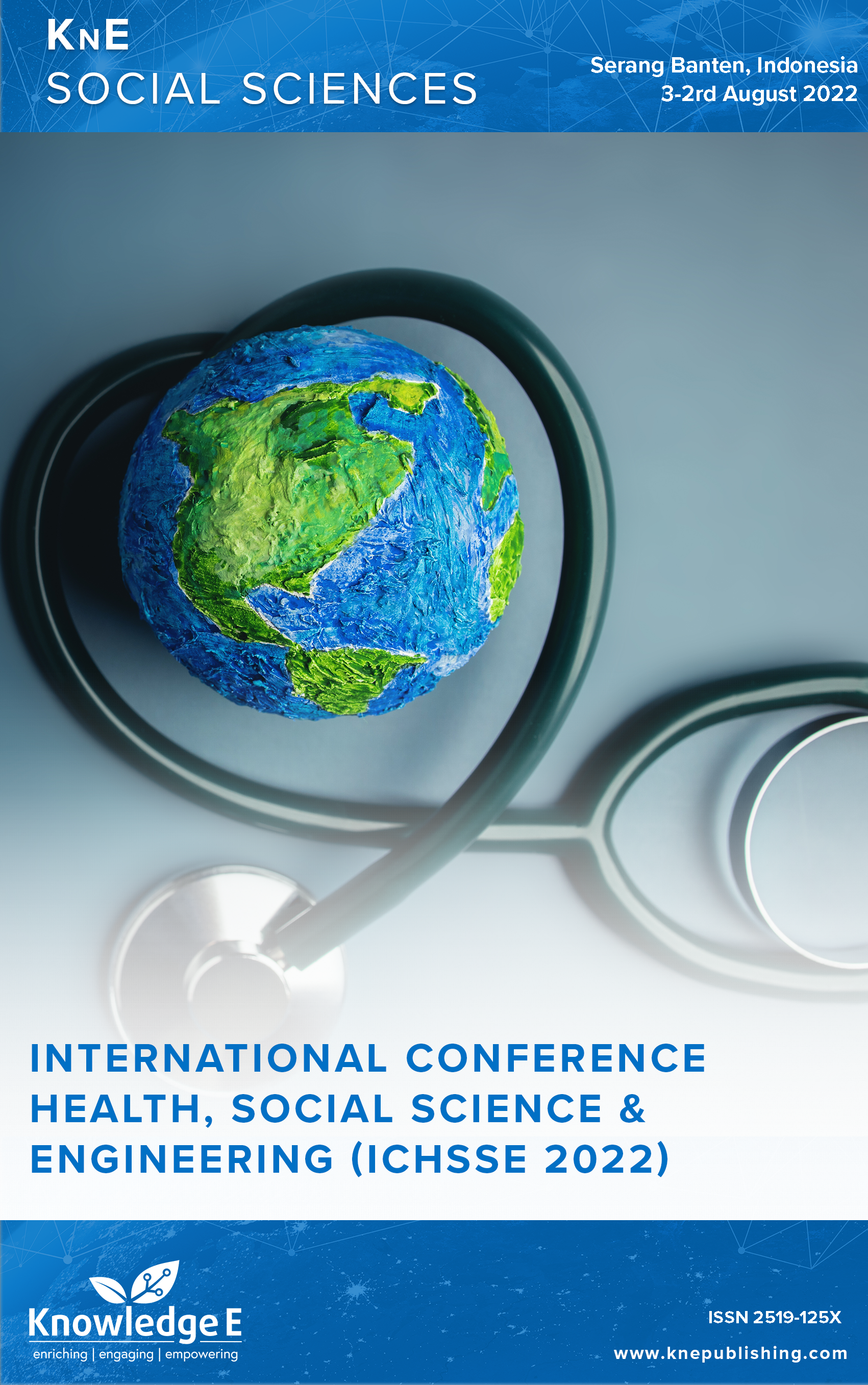Effectiveness of Wudhu to Reducing Anxiety During Competency Test on Students
DOI:
https://doi.org/10.18502/kss.v8i14.13826Abstract
Anxiety is an emotional response to individuals perspective thas was subjective and an unknown cause. National competency exams anxiety is one of psychological problems that nursing students often experience that is a fear of failure, getting bad grades, or cannot get through the exams. Therefore, there is a need to minimize anxiety. The treatment of anxiety can be with nonpharmacological therapy. One of the nonpharmacological therapy using hydotheraphy with wudu’ technique. This research aims to identify the effect of wudu’ on changes toward anxiety for nursing students in the national competency exam. The research design used in this research is preexperiment with single group design, pre- and post-test design. The research samples in this research were 24 respondents with simple random sampling technique. Instrument used in this research is Visual Analog Scale for Anxiety (VAS-A). Statistical test was doneusing wilcoxon signed-rank test, the obtained p-value = 0.000 (< 0.05), showed the influence of wudu’ on changes of anxiety for Universitas Faletehan nursing students anxiety in the national competency examination. Wudu’ contains elements of relaxation to reduce anxiety and provides benefits for physical, psyclogical, and emotional control. The results of this research can be used as a reference of nonpharmacological therapy to treat anxiety in national competency examination.
Keywords: anxiety, national competency test, wudhu’
References
[2] Davies T, Craig TKJ. ABC kesehatan mental. Jakarta: EGC; 2009.
[3] Stuart GW. Prinsip dan Praktik Keperawatan Kesehatan Jiwa Stuart, Edisi Indonesia 11. Elsevier Health Sciences; 2021.
[4] Videbeck S, Videbeck S. Psychiatric-mental health nursing. Lippincott Williams & Wilkins; 2013.
[5] Stuart GW. Evidence-based psychiatric nursing practice: Rhetoric or reality. J Am Psychiatr Nurses Assoc. 2001;7(4):103–114.
[6] Mamuaya MH, Elim C, Kandou LFJ. Gambaran tingkat kecemasan dengan pengukuran TMAS dan prestasi belajar siswa perempuan dan laki-laki kelas 1 SMA Negeri 1 Kawangkoan. e-CliniC. 2016;4(2).
[7] Kaplan HI, Sadock BJ, Grebb JA. Sinopsis psikiatri: Ilmu pengetahuan perilaku psikiatri klinis. Dr I Made Wiguna S Jakarta: Bina Rupa Aksara. 2010;113–129.
[8] Yosep I. Keperawatan jiwa. Bandung: Refika Aditama; 2007.
[9] Santrock JW. Perkembangan remaja jilid 2 (Edisi 11). Jakarta: Erlangga; 2007.
[10] Jakobsen JC, Hansen JL, Simonsen S, Simonsen E, Gluud C. Effects of cognitive therapy versus interpersonal psychotherapy in patients with major depressive disorder: a systematic review of randomized clinical trials with meta-analyses and trial sequential analyses. Psychol Med. 2012;42(7):1343–1357.
[11] Maciejewski DF, Van Lier PAC, Neumann A, Van der Giessen D, Branje SJT, Meeus WHJ, et al. The development of adolescent generalized anxiety and depressive symptoms in the context of adolescent mood variability and parent-adolescent negative interactions. J Abnorm Child Psychol. 2014;42:515–526.
[12] Hurlock EB. Perkembangan anak jilid 1. 2020.
[13] Al Mighwar M. Psikologi Remaja. Bandung: CV Pustaka Setia; 2006.
[14] Andriansyah T, Sari EKW. Tingkat kecemasan siswa dalam menghadapi ujian nasional berbasis komputer (UNBK) di SMK Al Munawwariyyah Bululawang. JKI ( J Konseling Indo). 2017;2(2):44–49.
[15] Fulcher R, Mullin CM. A data-driven examination of the impact of associate and bachelor’s degree programs on the nation’s nursing workforce. Policy brief. 2011.
[16] Council NR. The role of human factors in home health care: Workshop summary. 2010.
[17] Natalia L, Sinaga A. Relationship of students motivation with national competency exam result in the nurse profession program of immanuel school of health sciences Bandung. KnE Life Sciences. 2021;363–370.
[18] Witmer JM, Sweeney TJ. A holistic model for wellness and prevention over the life span. J Counsel Dev. 1992;71(2):140–148.
[19] Perwataningrum CY, Prabandari YS, Sulistyarini RI. Pengaruh Terapi Relaksasi Zikir Terhadap Penurunan Tingkat Kecemasan Pada Penderita Dispepsia. JIP ( Jurnal Intervensi Psikologi). 2016;8(2):147–164.
[20] Akrom M. Terapi Wudhu. Mutiara Media; 2010.
[21] Uthman NM. Al-Quran wa cIlm al-Nafs. Kaherah: Dar al-Shuruq; 1985.
[22] Ibrahim MA. Allah Begitu Dekat dan Mendengar Keluh Kesahmu. LAKSANA.
[23] Puspitasari R. Pola Hidup Sehat Menurut Al-Qur’an:(Kajian Maudhu’i Terhadap Ayatayat Kesehatan). INOVATIF: Jurnal Penelitian Pendidikan, Agama, dan Kebudayaan. 2022;8(1):133–163.
[24] Afif M, Khasanah U. Urgensi Wudhu dan Relevansinya Bagi Kesehatan (Kajian Ma’anil Hadits) dalam Perspektif Imam Musbikin. Riwayah: Jurnal Studi Hadis. 2018;3(2):215– 230.
[25] Kusumawardani D. Makna Wudhu dalam Kehidupan menurut Al-Qur’an dan Hadis. Jurnal Riset Agama. 2021;1(1):107–118.
[26] Cohen J. Statistical power analysis for the behavioral sciences. Hillsdale: NJ : Erlbaum; 1988.
[27] Ruland CM, Moore SM. Theory construction based on standards of care: A proposed theory of the peaceful end of life. Nurs Outlook. 1998;46(4):169–175.
[28] James H, Paton D. Social capital and the cultural contexts of disaster recovery outcomes in myanmar and taiwan. Global Change, Peace and Security. 2015.
[29] el-Bantanie MS. Shalat Tolak Miskin. Elex Media Komputindo; 2010.
[30] Syafi’ie el-Bantanie M. Quran stories for kids: Kumpulan Cerita Al-Quran Untuk Anak Pembentuk Karakter Islami. WahyuMedia; 2013.
[31] Zulaikhah S, Sulistyarini I. Kebersyukuran dan Subjective Well-Being pada Orang Tua Yang Memiliki Anak Penderita Thalassemia. Sintesis: Jurnal Bimbingan Konseling. 2023;1(1):30–35.
[32] Suryantara B, Qolbu W. Perbaiki Shalatmu Agar Allah Perbaiki Hidupmu. WahyuQolbu; 2019.
[33] Al-Khuly SH. Misteri Dahsyatnya Gerakan Shalat: Menyingkap Rahasia Sehat Dan Bugar Dibalik Gerakan Shalat. Tuhfa Media; 2010.
[34] Yusuf UM. Hidup Sukses dengan Tahajjud. KAKTUS; 2018.

